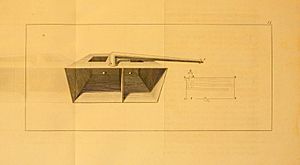Charles Irving (surgeon) facts for kids
Charles Irving was a Scottish naval surgeon and inventor. He lived from about 1768 to 1781.
In 1770, he showed the Royal Navy a new way to make fresh water from seawater. This process is called distillation. For his invention, he received a large sum of £5,000 in 1772.
His special machine for distilling seawater was used on James Cook's second voyage. It was also used on the 1773 expedition towards the North Pole. On this trip, Irving was both a surgeon and a scientist with Constantine John Phipps. Later, Irving tried to set up British colonies in Central America. However, his plans were stopped by Spain.
Contents
Early Life and Connections
Charles Irving was born in Holywood, Dumfriesshire, Scotland. His parents were William Irving and Katherine Menzies. We don't know exactly how he became a surgeon.
In 1768, while living in London, he hired Olaudah Equiano. Equiano was a freedman, also known as Gustavus Vassa. Equiano worked for Irving as a hairdresser. In his book, Equiano wrote that Irving was a "great master." He even let Equiano go to school in the evenings.
Making Fresh Water from Seawater
Irving showed his method for distilling seawater to the Royal Navy in 1770. In January 1771, he demonstrated his machine on HMS Arrogant. This was done for the Admiralty, which managed the navy.
Irving's machine was similar to one by James Lind. But Lind still said Irving's method was new and worked well. Lord Sandwich, a top navy official, had the water tested. Scientist Richard Watson found it was mostly fresh. Another scientist, Joseph Priestley, tasted the water. He said it was "perfectly sweet."
On May 11, 1772, Parliament gave Irving £5,000 for his invention.
His distillation machine was put on both ships of James Cook's second voyage. These ships were HMS Resolution and HMS Adventure. The machine allowed sailors to make fresh water while cooking food. Irving also helped Johann Reinhold Forster become the naturalist on Cook's voyage. During the trip, Forster studied how well Irving's machine worked.
Journey to the North Pole
In 1773, an expedition set out to reach the North Pole. The ships were HMS Racehorse and HMS Carcass. They were led by Constantine John Phipps. Their goal was to sail north between Spitsbergen and Greenland.
Irving joined the Racehorse as the surgeon. Olaudah Equiano also joined as a sailor and Irving's helper. Irving's water distillation machine worked well on board. Irving also helped Phipps measure water temperatures at different depths. He even invented a special insulated bottle, called the Irving bottle, for this.
The expedition sailed as far north as 80°48′N. However, they could not go further because of thick ice. Phipps wrote a report about the journey in 1774. Irving added a section about his distillation machine.
Plans for Colonies and Death
In 1775, Irving hosted a group of Mosquito Indians from Central America in London. He wanted to become the leader of the British-controlled Mosquito Shore. Irving hoped to create a British colony there with many settlers.
He and his business partner, Alexander Blair, sailed to the West Indies in 1775. Equiano and the Mosquito Indians went with them. In Jamaica, they bought enslaved people from West Africa. They planned to start a sugar plantation. However, their ship was seized by Spanish coast guards. Irving and Blair lost a lot of money.
From 1779 to 1781, Irving was involved in British efforts in Nicaragua. The British later lost interest in the Mosquito Shore.
Some sources say Irving died in Jamaica in 1794. However, Equiano thought he died earlier, around 1776 or 1777. Other writings from the 1780s and 1790s also mention him as having already passed away.
About His Name
Charles Irving's name sometimes appears as Irvine or Irwin. He has also been confused with another person named Christopher Irving. Christopher Irving invented a "marine chair" for astronomy at sea. But Christopher Irving died in 1764, much earlier than Charles Irving.
|


